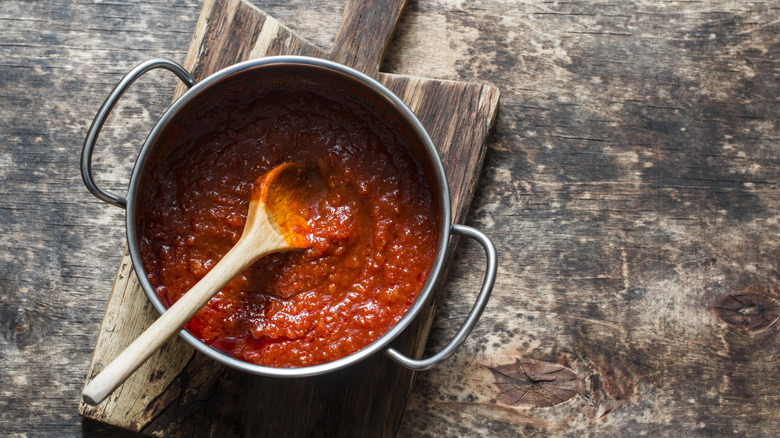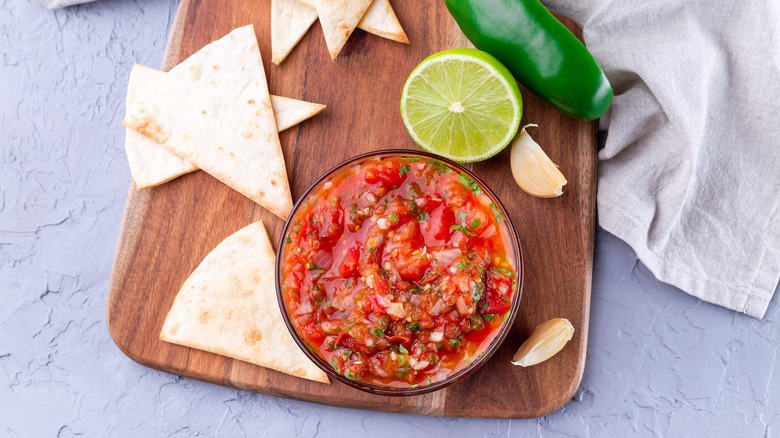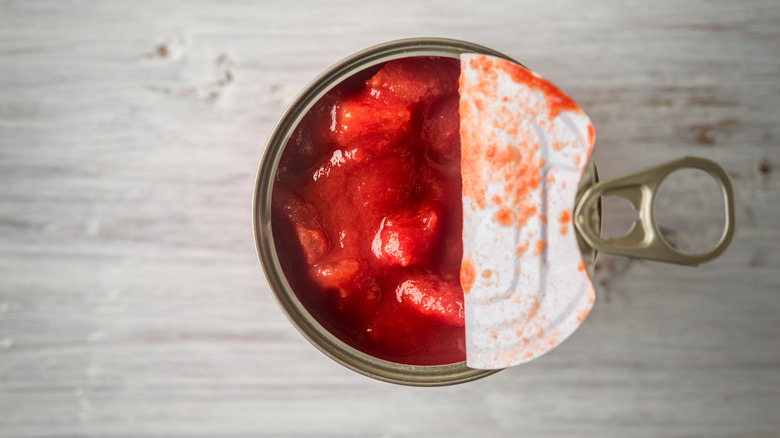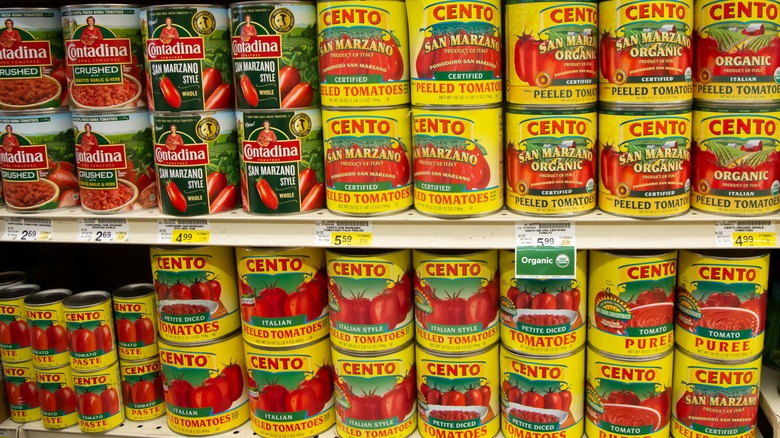13 Ways To Make Canned Tomatoes Taste Gourmet
We may receive a commission on purchases made from links.
Maybe you're the kind of person who uses canned tomatoes all the time. Or maybe you only use them when you're trying to cut corners. Either way, canned tomatoes are unbelievably convenient and versatile. They may not have the same fresh flavor as the ones you get from the produce section, and some brands have a metallic taste that isn't ideal, but there's no denying they make whipping up a world of dishes super easy.
If you're wondering how to counteract the straight-from-the-can flavor of tomatoes bought in a tin, you're in luck. You can do several things to make canned tomatoes taste more gourmet. They may never taste like fresh tomatoes picked in the middle of summer. Still, you can certainly take canned tomatoes well beyond their initial state by balancing acidity, enhancing sweetness, deepening flavor, and more.
We searched through Reddit forums, online blogs, and chef recommendations to find the best tips for making canned tomatoes taste more gourmet. What we learned may seem simple, but the payoff is huge. Use one or more of the tricks you find below and you'll be glad you did.
Simmer tomatoes to reduce some of the straight-from-the-can flavor
When opting for canned tomatoes, avoiding the straight-from-the-can flavor is of utmost importance. Not only is it a dead giveaway that you didn't use fresh tomatoes, but a lingering metallic taste isn't ideal, regardless of how you plan on using them. One of the best, easiest ways to reduce the unwanted flavor is to simmer them on the stove. While canned tomatoes are already cooked, additional time on the stove dries up excess moisture and helps concentrate sweetness — two things that lead to better flavor when you incorporate them into a recipe.
For most recipes, you can toss diced tomatoes straight into a pan for simmering. However, if you are making a sauce, you should consider crushing or puréing them first. That is, of course, if your can doesn't already come that way. As it turns out, you can buy them puréed, diced, crushed, or whole. If you don't have the ideal texture to start with, make it so with a bit of help from your blender or food processor before heating them on the stove.
Roast canned tomatoes to concentrate flavor and reduce moisture
Unfortunately, some cans of tomatoes lack any semblance of intensity when it comes to taste. However, you can change that by roasting them in the oven. Oven roasted tomatoes have an intense, bright flavor that people love and there's no reason you can't put canned tomatoes through the same process. In fact, it helps in two ways. First, it minimizes moisture. Second, it helps concentrate the flavor, effectively taking cheaper brands from bland to flavorful with minimal effort.
Roasting canned tomatoes is as easy as spreading them out on a baking sheet (possibly lined with parchment paper) and baking them in the oven at 300 F. The length of time required varies based on what type of canned tomatoes you are using (diced, whole, etcetera), but you will know they are done when all of the excess liquid has evaporated and they look like they are starting to dry on the outside. They should still be moist on the inside, though. This could take as long as an hour, but your patience will be rewarded in the flavor department. If you are roasting whole canned tomatoes, you should also drain them and break them open on the pan before baking. Otherwise, they'll take a ridiculously long time to roast and concentrate flavor.
Strain and caramelize canned tomatoes to enhance sweetness
Many canned tomatoes pale in comparison to fresh ones regarding their level of sweetness and lack of acidity. Actually, those are two of the reasons people prefer fresh over canned. However, you can easily intensify the sweetness and acidity by caramelizing them in a pan. Caramelizing canned tomatoes develops the natural sweetness of the fruit and concentrates their acidity, too. Best of all, you won't need any other ingredients to pull this trick off. You just need a pan and your stovetop.
To start, you'll want to drain your canned tomatoes well. Then, put them in a pan and cook on low until you start to see the edges turning brown — AKA caramelizing. This could take 30 minutes or more, depending on how many tomatoes you have in the pan, but keep cooking low and slow until you see a change. It may not be the quickest solution, but the deep sweetness and noticeable acidity that emerges is well worth the wait.
Balance the acidity of canned tomatoes with citrus, baking soda, or vinegar
Balancing acidity in canned tomatoes is a must if you want them to taste more gourmet, which, of course, we all do. Fortunately, you can easily balance acidity in canned tomatoes just like you would with other foods; by adding citrus, baking soda, or vinegar. In most cases, just a touch of any of those ingredients will do, so don't go overboard. Start by adding a small amount and then give your tomatoes a taste. You can always add more, but taking some out isn't so easy. In fact, it isn't really possible. If you do go too far, your only real option is to add more canned tomatoes.
While any of the acidity balancing ingredients listed above are game changers, baking soda is the key to transforming overly bitter canned tomatoes. As mentioned, you don't need much either. If you seek a brighter flavor, reach for citrus. It easily lifts flavor and minimizes acidity along the way. We prefer lemon, unless we're making Hispanic food, then we use lime. When it comes to vinegar, we typically use white vinegar to balance acidity in my cooking, but we often use balsamic vinegar when we want to simultaneously improve sweetness, as well. It does change the color a bit but the flavor is perfect in tomatoes when you're making bruschetta and other Italian-style creations.
Enhance sweetness with carrot or a pinch of sugar
Lower quality canned tomatoes often need a little help in the sweetness department. If you pop open a can and find they are lacking the sweetness you desire, you can easily remedy it by adding a pinch of sugar or a carrot to the mix. We use both of these tricks all of the time when we need to reduce acidity and enhance the sweetness of homemade marinara, which we often make with canned tomatoes and tomato paste, and they work wonders.
You don't have to take our word for it, though. Celebrity chef Giada De Laurentiis is also a big fan of the carrot trick when making tomato sauce, so even if it sounds strange, it definitely provides results. In addition, you can always try some direct pinches of sugar if you're afraid of a carrot taste in your dish.
If you want to try the carrot trick, put a large chunk of peeled carrot into your sauce or can of tomatoes. While cooking, the carrot will soak up extra acidity while simultaneously contributing sweetness, leaving you with a smoother taste. When the tomatoes or sauce are done, simply remove the carrot and you're all set. If it isn't sweet enough, add a pinch of sugar.
Season canned tomatoes generously to deepen flavor
Just like with any food, seasoning goes a long way with canned tomatoes. Some brands include some type of seasoning already, but adding your own is always an excellent idea. After all, the idea is to make them taste gourmet, right?
When seasoning canned tomatoes with herbs and spices, nothing is off the table. If you think about this, it makes perfect sense because you find tomatoes in almost every type of regional food from around the world. So, if you are wondering what to put in your canned tomatoes, just stick with the regional flavors of whatever recipe you're preparing. For example, if you're making Italian food, season your tomatoes with basil, garlic, thyme, and oregano. When making Mexican cuisine, add seasonings like cilantro, lime, paprika, cumin, and maybe even cayenne pepper if you enjoy a touch of heat.
As you probably know, fresh herbs and spices add the most flavor. However, if you only have dried herbs on hand they'll definitely get the job done. You may just want to add more than you would with fresh herbs and spices because they don't pack as much of a punch potency-wise.
Strain off and freeze extra juice for use in stews, sauces, and more
Straining your canned tomatoes is recommended for many recipes. However, there's no need to throw away all that extra tomato juice. Instead, drain it into a container and save it for use in other ways. It makes the perfect addition to soups, stews, and sauces that could benefit from a bit of extra flavor. Or, they work as a base for chilis, tomato sauce, or pretty much anything that needs some saucy tomato flavor. Plus, finding a way to use the juice that comes in your can of tomatoes minimizes your food waste, which is always a good thing.
Strained tomato juice should be good in the fridge for about a week as long as it is in an airtight container. If you don't anticipate using it that quickly, you can always freeze it too. When freezing, pour it into ice cube trays and then transfer the frozen cubes to a sealed bag until you need them. That way, you can easily portion out how much you use without having to unfreeze an entire batch. When frozen, these tomato ice cubes are perfect for cooling a soup that is too hot or putting in a Bloody Mary. Of course, they can be used in recipes, as well.
Combine with fresh tomatoes to brighten flavor
Canned tomatoes are great for bulking up a recipe, but what if you still want some of the fresh, bright flavor associated with fresh tomatoes? Well, the easy solution is to simply combine the two. Adding fresh tomatoes to canned ones acts as camouflage for the tin-like flavor we all want to avoid. As noted, it also gives whatever you are making lots of bulk, so you can stretch fresh tomatoes further. If canned tomatoes aren't your go-to, this simple trick might just change how you feel about them.
When you make a recipe that calls for raw tomatoes, canned ones typically aren't a great substitute. However, if you combine the two, the resulting mix is much more accommodating to fresh recipes. So, if you are making bruschetta, topping salads, or garnishing Mexican dishes like burritos and nachos, a mix of canned and fresh tomatoes is ready to step in. A combination of fresh and canned tomatoes also elevates flavor in recipes that call for cooked tomatoes, like sauces, soups, curries, and more. Whether you are roasting, simmering, or sautéing them, adding fresh tomatoes to the mix infuses the dish with the fresh flavor we all love.
Buy low sodium canned tomatoes for complete control over the flavor
If you aren't already on high alert about your sodium intake you may think, why bother with no salt added options? Still, if you want to maintain complete control over a recipe (who doesn't?), low sodium products are a fantastic option. They allow you to add as much or as little salt as you like. Plus, salt affects the taste of other added ingredients too, so to ensure you get the exact flavor you want, it is often best to start from scratch. That way you can manipulate all of the seasonings to match your precise preferences.
The amount of salt in a can of tomatoes varies from one brand to the next, but it is a common ingredient because it acts as a preservative. Even so, the difference between regular and low sodium options is quite drastic, so it truly does make a noticeable difference. For example, Amazon Fresh No Salt Added Diced Tomatoes have 15 milligrams of sodium per serving, but regular Amazon Fresh Diced Tomatoes contain 180 milligrams of sodium per serving. That's a pretty significant difference, and it shows in the flavor. While regular options with higher sodium don't taste bad, they do take some of your control away regarding flavor. So, stick to the no salt added or low sodium options if you want to use your own blend of seasonings.
Blend before cooking to make the smoothest sauces
Canned tomatoes are great for making soups and sauces. For the most part, they tend to break down quite a bit while cooking, but if your goal is a super smooth texture, blending your tomatoes first is recommended. Even if you start with a can of crushed tomatoes, which still contain small lumps, your blender can smooth things out in just a few seconds. As a result, you get a serious head start regarding consistency. In addition, you may not need to cook your sauce or soup for nearly as long because the texture starts close to perfect. We still like to cook our tomato sauce for several hours because it gives herbs and spices a chance to deepen flavor, but if you're in a hurry, blending is your friend.
While improving the texture of canned tomatoes by blending doesn't necessarily imply improved flavor, the finished consistency goes a long way in enhancing your overall experience and enjoyment of a dish. We're not saying you should skip seasoning and other tricks listed in this article if you blend your canned tomatoes. You'll still want to do that, but a super smooth texture is a big perk for various soups, classic tomato sauces, and other tomato-based sauces. Give it a try and you'll see what we mean. The only time we wouldn't recommend blending first is if you are making a more rustic tomato sauce and a certain level of chunkiness is desired.
Revive fresh summer flavor with a pinch of cream of tartar
If you aren't much of a baker, cream of tartar may not be an ingredient you keep around. Heck, maybe you've never even heard of it. However, it can be a big help when you're looking to reduce the metallic element and improve the flavor of canned tomatoes overall. Cream of tartar also helps add acidity without overpowering the inherent taste of tomatoes, like other acidic elements will (I'm looking at you vinegar and citrus).
In addition to balancing the acidity levels of canned tomatoes, cream of tartar also helps to revive some of the summer flavor found in fresh tomatoes. Who doesn't like that? It won't convince you that your canned tomatoes are fresh, but it definitely makes a noticeable difference. So, if you have a jar of cream of tartar in the back of your pantry or on your spice rack and are looking for a way to put it to good use, canned tomatoes are just the thing. Even if you don't already have a jar of it, it is worth picking one up just for this simple trick.
Mix into countless flavorful recipes
One of the best things you can do to make canned tomatoes taste more gourmet is to simply mix them into a recipe. Combined with other ingredients, there's no limit to how you can alter flavor and improve taste overall. Plus, there's basically an infinite number of recipes that call for tomatoes and canned ones work great in most of them. Sure, fresh tomatoes have their benefits but don't underestimate canned ones when it comes to mixing them into tasty cooked dishes.
Some of my favorite ways to use canned tomatoes are in marinara and tomato salsa. Mixing them with Hispanic and Italian flavors leads to such delicious results many people won't even know the tomatoes came from a can. Of course, blending them doesn't hurt, either. Canned tomatoes are also perfect in dishes like slow-cooker chili, stir-fry, roasted tomato soup, Indian and Asian curries, and much more. Really, there are so many ways to incorporate canned tomatoes into your cooking that they are one of the canned foods you'll use all of the time if you keep them stocked in your pantry. They're incredibly inexpensive, too, and they won't go bad if you forget to use them straight away, like fresh tomatoes do.
Give yourself a head start by always purchasing quality canned tomatoes
This probably isn't a surprise, but starting with quality canned tomatoes is an outstanding way to give yourself a head start in the flavor department. As it turns out, the brand you choose makes quite a bit of difference. We recently taste-tested and ranked popular canned tomato brands, and we found the taste varied much more than we originally expected. Our top three brands include Cento, Delallo, and Contadina. However, you may have your own favorites. Whatever they are, stick to them, even if they do cost a bit more.
On a Reddit thread about reducing the metallic taste of canned tomatoes, people tend to agree that the brand you buy makes a huge difference regarding taste. One commenter had this to say: "Instead of just grabbing whatever canned tomatoes there are, look in the Italian section for the ones they have" because they provide a "much better flavor and nowhere near as much metallic tang." We couldn't agree more, and once you give Italian tomatoes a try, something tells us you will, too. They tend to have a much brighter, fresher flavor. They also are a touch sweeter, so you may not need to add sugar or carrots to sweeten them up like you would with other, lesser brands.














